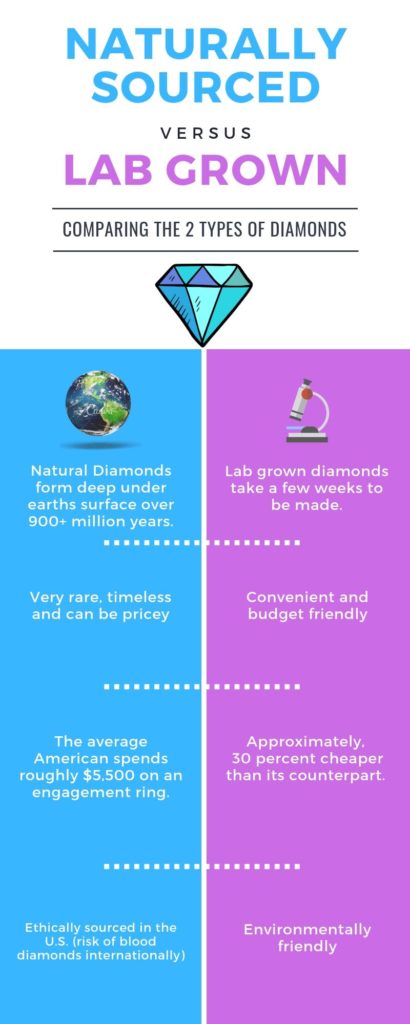Not known Incorrect Statements About Lab Grown Diamonds
Wiki Article
Examine This Report about Lab Grown Diamonds
Table of ContentsGet This Report on Lab Grown DiamondsSome Known Facts About Lab Grown Diamonds.The 25-Second Trick For Lab Grown DiamondsTop Guidelines Of Lab Grown Diamonds
As you travel closer to the Earth's core, stress and temperature increase, which develops the excellent stove for carbon to be converted into ruby (diamonds are the only gemstone to be made from simply one element). Via a massive volcanic eruption, these rubies were delivered to the Earth's surface area. It's estimated this process was rather fast (probably throughout several hours), which allowed the diamonds to stay undamaged without melting.The brief answer: carats determine the mass of rocks, karats measure the pureness of gold. Carat weight: 1 carat weight amounts to 0.2 grams, concerning the weight of a paperclip (next time you see an image of Mariah Carey's 35 carat interaction ring, just imagine the problem of lugging 35 paper clips around your finger each day).

Below are a few of the key advantages of lab expanded rubies and lab grown diamond jewelry:.
What Does Lab Grown Diamonds Mean?
Simply put, natural or earth-mined diamonds are crafted over millions of years beneath the Earth's crust from pure carbon combined with pressure and warmth. Developing diamonds in a lab needs the same procedure, just fine-tuned to take area over a much smaller sized period in a far more regulated setting.Whereas earth-mined diamonds are rare and finite and tend to increase in cost over time, laboratory rubies are readily offered., like lab-grown ruby rings, they won't be an excellent fit for your requirements.
They might assume that the cons of lab-grown diamonds outweigh the pros. Problems, wars, and civils rights concerns are all intermingled with the ruby sector. That claimed, the diamond market does give income to third-world countries. Some might argue that, for this reason, buying a lab-made ruby also comes with its honest considerations, as doing so takes earnings away from those included in the natural diamond market who might need it most.
Traditional rubies depend on the Planet's problems to determine their quality or lack thereof. In a lab, makers can directly control a ruby's quality.
Some Of Lab Grown Diamonds
You can easily find colored, synthetic rubies on the (fairly) low-cost side as well as specific cuts that would certainly be more expensive if you were going shopping for an extracted his comment is here diamond only. That rarely suggests it isn't worth shielding.natural rubies is that the latter is extracted from all-natural down payments in the Earth while the previous is made in a lab utilizing controlled setups. Their high quality is greatly the very same. While the distinction in between lab-grown and all-natural ruby options are marginal when it comes to top quality, some of the disadvantages of lab-grown rubies include the fact that the rock will certainly depreciate over time and, to some, an absence of nostalgic value that's usually linked with mined rubies
The procedure includes minimal land disruption and eliminates issues associated with deforestation and habitat destruction. Lab-grown diamonds are usually extra affordable than all-natural rubies. This cost difference can be connected to the structured production procedure and the avoidance of expenditures related to traditional mining. The Controlled Atmosphere in Which Laboratory Grown Diamonds Are Created Allows for Constant High Quality.
Adaptability in Style - Lab Grown Diamonds Offer Designers and Customers a Versatile Scheme to Create Unique and Cutting-edge Jewelry Styles - Lab Grown Diamonds. Lab Diamonds Commonly Come with A More Clear Supply Chain.
Excitement About Lab Grown Diamonds
Market Understanding - In Spite Of Their Similar Physical Properties, Lab Diamonds Might Face Tests in Market Perception. Some Consumers Still Perceive Natural Diamonds as Having Greater Value and Status. The Production of Lab-Grown here Diamonds Can Be Energy-Intensive, Specifically in Methods Like High Stress High Temperature (hpht) and Chemical Vapor Deposition (cvd).Natural Diamonds Are Created Over Numerous Years Deep Within the Earth, Contributing to Their Viewed Rarity. Lab-Grown Diamonds, In Spite Of Their Similar Characteristic, Might Not Lug the Same Rarity Factor, Affecting Their Perceived Worth for Some Consumers. Effect on Diamond-Dependent Economic Climates - the Change In The Direction Of Lab Grown Diamonds Might Have Financial Implications for Countries and Areas that Depend on The Diamond Mining Market.

Laboratory Rubies Are of Equal High Quality to Natural Diamonds in Terms of Solidity, Sparkle, and Quality - Lab Grown Diamonds. Yes, Laboratory Diamonds Glimmer Just Like Natural Diamonds. Their Brilliance and Glimmer Are a Result of Their Cut and The Means Light Communicates with Their Facets.
Report this wiki page